Veterans’s Testimony – Alfred G. Myhill Second Hospitalization Unit, 53d Field Hospital

Early portrait of Private Alfred G. Myhill, ASN 12214882, taken shortly after his entry into active service.
Introduction:
My name is Alfred G. Myhill, I was born 21 April 1925 in Oswego County, Fulton, New York.
After attending Grammar School and 2 years of agricultural studies at Fulton High School, I quit High School and worked as a farmhand on local farms and helping my father, Milford Myhill on the family farm from 1941 to 1942. My job consisted of planting and harvesting crops and feeding, tending, and milking cows. I often operated a tractor and other farm machinery and drove a light truck for the farm. I also delivered groceries for a small family-owned grocer named Loughery in Granby Center. From 1942 to 1943 I was employed at the American Woolen Mill making wool and khaki cloth for the Army. I dropped what I was doing to join other young Americans in an effort to fight Nazism and was one of three Fulton men to be awarded my High School diploma decades later (as a matter of fact, Alfred Myhill obtained his High School diploma at the School’s Board meeting held 13 March 2001 –ed).
Many youngsters made sacrifices to join the ranks in an effort to fight and preserve Democracy! I joined the Enlisted Reserve Corps (ERC) 15 February 1943 when I was 17 years of age. Having just turned 18 in April of 1943, along with my friend George Chilson, I officially entered into active service 21 May 1943 in Syracuse, New York. After joining the Regular Army and being assigned Army Serial Number 12214882, I became another Private in Uncle Sam’s Army, in the Second Service Command area (grouping the States of Delaware, New Jersey and New York) which operated under jurisdiction of the First United States Army.
Training:
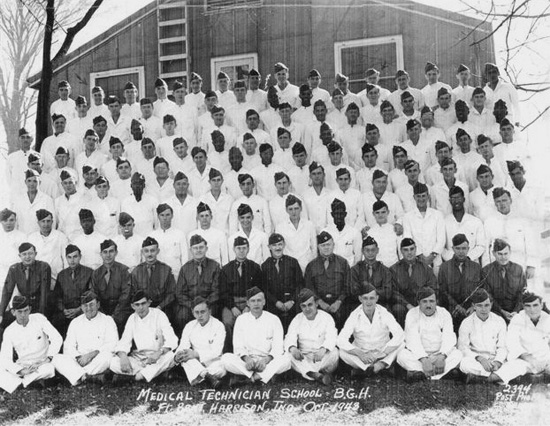
Fort Benjamin Harrison, Indianapolis, Indiana, October 1943. Picture of students taken during Private A. Myhill’s training at the “Medical Technicians School”.
I took my 8 week Basic Training at Camp Pickett, Blackstone, Virginia (Division Camp, total acreage 45, 867, troop capacity 2,363 Off & 41,552 EM –ed) and several more weeks of Medical Technician Training in 1943 at the Enlisted Men’s Technical School, Fort Benjamin Harrison, Indianapolis, Indiana (also housing the Finance Replacement Training Center, total acreage 2,923, troop capacity 736 Off & 13,632 EM –ed). The Master Training Program at the time represented some 572 hours consisting of three distinct phases: Basic – Technical – Tactical & Logistical subjects. After being trained as a Medical Technician, I went to Lawson General Hospital in Atlanta, Georgia to gain practical experience. While at Lawson General Hospital I was assigned to the 52d General Hospital (affiliated to Syracuse University, New York, activated 1 September 1942, embarked for England 6 January 1943 –ed) to go to England and be located in a large military hospital in either London, England, or eventually Paris, France, as needed. My military occupational assignments were mainly based on acquiring knowledge of medical technique and operation. My various MOS (Military Occupational Specialty) numbers represented Basic Medical Training (MOS 657), which I took as a Private and covered 3 months to complete; followed by Medical Technician Training (MOS 409), which lasted 20 months; and another 2 months of training as a Basic Dental Technician or Chair Assistant (MOS 855). By then I was already a Technician 5th Grade.
Assignment:
My final assignment was to be the 53d Field Hospital, originally activated as the 229th Station Hospital on 25 February 1943 at Camp Rucker, Ozark, Alabama (Division Camp, total acreage 58,999, troop capacity 3,280 Off & 39,461 EM –ed) under T/O & E 8-560 dated 22 July 1942. The Hospital’s official activation was based on GO # 11, Headquarters, Fourth Service Command (with Headquarters in Atlanta, Georgia, under jurisdiction of Third United States Army) dated 4 February 1943. Official re-designation to 53d Field Hospital in fact took place at Camp Ellis, Table Grove, Illinois (Army Service Forces Training Center, total acreage 17,503, troop capacity 1,795 Off & 24,654 EM –ed), and became effective 10 December 1943.
The majority of the Enlisted Men, like me, joined from various camps in the First, Second, Third, and Fourth Service Commands, Zone of Interior. The organization left Camp Ellis with 9 Officers and 162 EM and departed with destination Fort Bragg, Fayetteville, North Carolina (Field Artillery Replacement Training Center, total acreage 129,422, troop capacity 4,311 Off & 76,175 EM – ed) on 24 February 1944.
The unit was filled up to authorized strength for possible overseas duty. More Medical Officers were assigned from the Third, Fourth, and Eighth Service Commands. A new Chaplain was transferred from Camp Davis, Wilmington, North Carolina (Antiaircraft Artillery School & Training Center, total acreage 35,518, troop capacity 1,978 Off & 35,327 EM –ed); 1 MAC Officer arrived from Camp McCain, Grenada, Mississippi (Division Camp, total acreage 42,243, troop capacity 2,779 Off & 39,341 EM –ed); 18 ANC Officers came from the Second and Fourth Service Commands. In the end, the 53d would depart Fort Bragg 15 April 1944 for Camp Kilmer with full strength of all personnel – 22 Officers, 18 Nurses, and 190 Enlisted Men.
While at Fort Bragg, North Carolina, training continued, including classes and field exercises such as convoy driving, blackout driving, bivouac setup, camouflage principles, map and compass reading, bomb disposal, demolitions, gas attack, etc.
The Commanding Officer, Lieutenant Colonel Cornelius F. Lehmann, O-157864, MC, was assigned from Brooke General Hospital, Fort Sam Houston, San Antonio, Texas. 5 MAC Officers came from OCS, Class # Ten, Camp Barkeley, Abilene, Texas (Armored Division & Medical Replacement Training Center, total acreage 69,879, troop capacity 3,192 Off & 54,493 EM –ed); 25 Nurses came in from the First Service Command on 5 September 1943; and 2 Dental Officers were assigned during July-August 1943. First Lieutenant Erwin E. Heckman, O-525852, ChC, was also transferred from First Service Command to the Hospital to become the unit’s Chaplain.
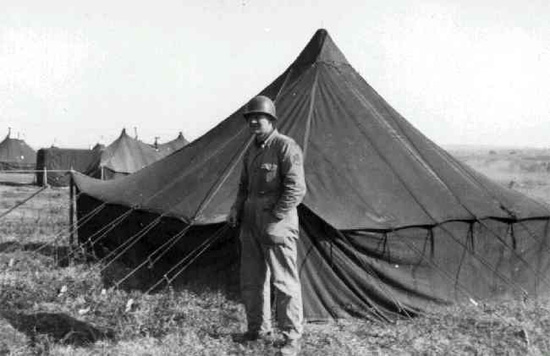
Typical view of M-1934 Fire-Resistant, Olive Drab, Pyramidal Tent (QMC Stock No. 24-T-320), as being used by the 53d Field Hospital and many other medical units.
My unit went by train to Camp Kilmer, Stelton, New Jersey (Staging Area for New York Port of Embarkation, total acreage 1,815, troop capacity 2,074 Off & 35,386 EM –ed) to be ready for shipping out. But fate played havoc with these plans. I got the mumps and was hospitalized shortly after arrival because I was so sick. As luck would have it my unit with whom I had trained for so many months was shipped out during my hospitalization. I was then put in a replacement pool. At the time when I was well again, I was granted leave to visit home for several days as my grandfather was very ill and did in fact subsequently die. I had notified my family that I would be coming and the leave would have me at home for my 19th birthday. However, this was not meant to be and at 1700 hrs on 20 April 1944, someone came to the barracks and called me downstairs yelling, “Myhill you’re shipping out.” The Sergeant hurriedly helped me get my things packed and they took me down to the dock at the Port of Embarkation Camp Kilmer, in Stelton, New Jersey. There was a line of soldiers in formation with all of their belongings. Among them was one empty space and the men took me and my duffel bag and stuck me in that empty space. Someone came along and chalked a number on my helmet. Soon I found myself walking up the gangplank of the “Queen Elizabeth” troopship (designated 515 NY). I left for overseas 20 April 1944, arriving in the European Theater of Operations 26 April 1944, and on my way to the United Kingdom instead of home on leave as planned. I didn’t have time to tell my folks where I was for the coming weeks, and never was I able to tell them I wasn’t coming home. It was a strange feeling to be in the middle of the ocean for my nineteenth birthday on a ship with so many people but not a soul I knew. Neither did I know the military unit with which I had been placed.
Overseas Service:
United Kingdom
Early in the morning of 20 April 1944, the “Queen Elizabeth” left New York harbor with destination the United Kingdom (as per orders dated 8 April 1944). Thanks to her speed, the ship was to sail alone into the Atlantic Ocean without any escort. The “Queen” was on her own for a number of days. To pass away the time, the lucky ones engaged in card and crap games, but there was never a dull moment, as many a soldier was either tied up in KP, water guard, or any other detail. I was assigned to water guard for 3-4 hours each day of the trip. Space on board was limited, bunks were in three tiers or sometimes six, just imagine the crowded, almost claustrophobic individual space per man. I was on the promenade level third bunk of six high. Chow lines were formed twice a day, as there were only two meals served daily, and ran almost like a snake across the many decks and stairways of the huge vessel. For several days, life on board was miserable, rough, cold, and murky. The danger of a sudden U-boat attack was never far away, and although not many people got seasick, sight of land finally brought some welcome relief.
After dropping anchor at Greenock, Scotland, 27 April 1944 and joining a multitude of other ships already in the harbor area, it took two more days for the men to debark. Everyone went ashore, complete with belongings and filed-up through the railway station before entraining for a new unknown destination. As we waited, women of the American Red Cross distributed coffee and donuts. Later, the soldiers were presented a set of 3 K-rations for the journey on the train. The trip made many among us discover parts of the UK we had never personally seen or heard of ever before – the ride went through Glasgow, and out of Scotland into England, and through Leeds and Manchester; it was quite a monotonous trip and quite long because our train had to often go on a siding to let other trains go by us. The weather was terrible with sun and rain alternating and very cold.
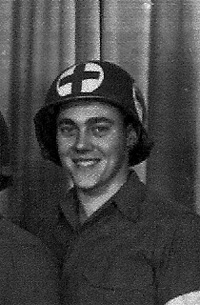
Field portrait of Alfred G. Myhill. He wears a M-1 steel helmet adorned with the GC symbols (red cross in a white circle).
In the evening of 29 April 1944, our group arrived at Hagley, Worcestershire, near Stourbridge, not far from Birmingham, one of the larger industrial cities in England. After reaching the railway station, we all marched toward Oldfield House which served as Headquarters and where we were served a hot meal (prepared by American cooks). Meals would be served from that point on at this single level building which was quite small. All soldiers from the 53d Field Hospital (my new outfit) would come to this building from all billeting locations for each meal. After supper, everyone went to sleep on the floor. The entire next day was spent with the assignment of billets. Oldfield House was an estate that belonged to a famous British cricket player and had beautiful grounds all around it. After some re-organization, re-assignments, and other necessary administration, a number of Nurses were assigned to the three Hospitalization Units (or Platoons). I recall that we welcomed 2 ARC girls while in England; Mary Christopher (Montana), and Ruth Cook (Colorado). The latter was often with our Platoon until she left shortly before VE-Day for the 11th Evacuation Hospital. I was assigned with 6-8 other men for billeting in Lord Cobham’s Estate in the village of Hagley. We set up in stacked bunk beds with straw mattresses in the basement level.
Stations in the United Kingdom – Second Hospitalization Unit, 53d Field Hospital
Hagley, Worcestershire – 29 Apr 44 > 7 Jul 44
Tidworth, Wiltshire – 7 Jul 44 > 12 Jul 44
Our CO, Lieutenant Colonel C. F. Lehmann, who had previously commanded the 229th Station Hospital at Camp Rucker, Alabama, and brought the 53d Field Hospital overseas, had been looking forward to go into action with ‘his’ boys. But this was not to be, as he was transferred on 16 June 1944 to the 82d General Hospital in the ZI to carry on with his specialty which was dermatology. He was later replaced by Lieutenant Colonel Clarence A. Bishop, O-358948, MC, who joined the unit from the 67th Medical Group.
Full-time training continued in England. Lectures and classes were held with the focus placed on medical handling of patients. Training films and training aids were used, followed by field exercises. Apart from daily calisthenics, road marches were held for all commissioned and enlisted personnel. A full week’s bivouac was held with all three Platoons participating. Cross-training was encouraged, with Enlisted Men being trained in jobs other than their specialty (some men ended up being trained for two or three jobs). Some Officers, Nurses, and Enlisted Men attended specialized courses at different Schools set up in England.

Charcoal portrait of A. G. Myhill made by a Frenchman in August 1944 in Brest, Brittany.
On 7 July 1944, my unit received orders to move to a new location. We left Hagley, England for a concentration area located near Tidworth (Swindon) England. This proved to be only a short stay, as the Hospital already left Tidworth for a marshaling area in the vicinity of Southampton, Southern England on 12 July. Between 13 and 14 July, the 53d moved by echelon to area C-5 where it was to subsequently board a ship for the Channel crossing.
France
The organization reached Normandy safely, arriving at Transient Area B (Utah Beach) on 15 July 1944. Officers and Nurses slept on benches in a nearby church, while the Enlisted Men pitched their individual tents in an orchard. The next morning after waiting for the necessary trucks to arrive, the organization left for Sénoville, and thence for Barneville (TUSA Medical Concentration Area), on the way there was nothing but wreckage of war. All along the roadside there were dead horses, equipment that was wrecked and on fire. When we reached Barneville, our CO called all of us out to see where a jeep had hit a landmine on the side of the road. It had killed one soldier and another had his coat completely shredded but was not injured. The Colonel was showing us what could happen if we went off the road or in a place that had not been cleared of mines. He wanted to warn us not to leave the area. Three fields had been selected, a large one for the hospital proper; another smaller one for the Officers, and a small orchard for the Nurses. It took two more weeks for our equipment to arrive; meanwhile a number of personnel went on DS to the 100th Evacuation Hospital.
On 28 July 1944, the 53d Fld Hosp received Federal Voting material such as Post Card Application Forms, Posters, and Pamphlets. 4 Voting Officers were appointed for Headquarters Platoon and each of the three Hospitalization Units, with the Adjutant of the command acting as General Voting Supervisor.
Following the newly-activated Third United States Army (1 Aug 44 ) into France, hopping over to the continent, leaving its precious and secure station in England, the 53d Field Hospital continued to follow the other Allied Forces as they swept through Western Europe toward Nazi Germany.
On 2 August 1944, the unit left Barneville in two convoys. The new bivouac area was La Lande. Four days later, we were all moving again and would soon become operational. Headquarters and all three Platoons were attached to VIII Corps for the duration of the Brittany campaign. The three Hospital Units moved by echelon, first the Third, then, the Second, and finally the First, by motor convoy. The next move continued further south to Lessay (another bivouac area), Coutances, Avranches, and finally into Brittany. While First Platoon was destined for St. Malo, the other two Platoons were headed respectively for Lorient and Ploudaniel. Several bivouacs were arranged for the journey with stops on the way to Ploudaniel, which was reached 8 August 1944. Our organization became officially operational on 6 August 1944. Transportation always remained a problem, there were simply never enough vehicles available, causing a considerable handicap for obtaining supplies and moving personnel. Additional trucks had to be borrowed or requisitioned, and if possible, captured enemy vehicles were pressed into service by the new owners. T/O & E 8-510, dated 31 August 1944 was never met as figures related to the number of required vehicles seemed to have been calculated for static operations. While at Ploudaniel, outside of Brest, we took a wrong road and got to a dead end. Remembering that we should not go off the road to turn around for fear of landmines, we drove into a barnyard and unhooked the trailer, turned the truck around and hooked the trailer up again. We had to do this for each vehicle and trailer being used for travel. It sure took quite a while to accomplish this but it was the safest way to go.
The first time the men ever set up to operate the hospital, the wounded started coming in right away. Everything was so new to us that it was difficult to take in and process. Everyone was nervous, confused and afraid of making a mistake because we were just starting out. It was at Brest that another guy and I were placing a body on a truck for Graves Registration when his leg fell off. The guy who was helping me couldn’t handle it and fell apart. He had to be transferred to the motor pool…
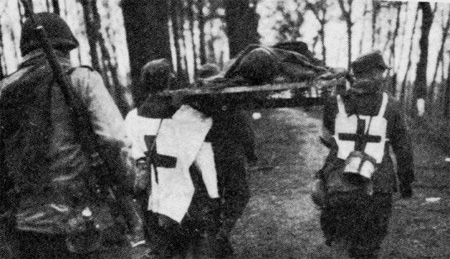
German medical personnel under guard of an American G.I. evacuate a casualty out of harm’s way. It is not known whether the wounded man was an American or a German. Note the red cross tabard worn by the litter bearers.
At our initial hospital set up, after 36 consecutive hours of trying to save the many wounded, I left the ward tent to retire and steal some sleep in my individual pup tent. When coming out after working all of those hours, at Brittany, in the city of Brest, there was a French artist who approached me. This person asked me if I wanted a portrait and although I was exhausted from working so long I had him do the drawing. He made a 14” x 18” charcoal drawing for which I gave him two packs of cigarettes, as I did not smoke. This took him only a few minutes and was done in August 1944. I forwarded it home to my parents, received it back from the homestead in 1988 and have since framed it along with some of my medals.
Stations in France – Second Hospitalization Unit, 53d Field Hospital
Ploudaniel, France – 8 Aug 44 > 23 Aug 44
Saint-Urbain, France – 23 Aug 44 > 10 Sep 44
Châteaulin, France – 10 Sep 44 > 26 Sep 44
Ploudaniel, France – 26 Sep 44 > 29 Sep 44
While at Ploudaniel, my Platoon supported the 4th Armored Division; then we switched over to provide medical care to the boys of the 6th Armored Division. Later we were asked to provide medical services to TF “A” comprising TD, Cavalry, and Engineer units acting as a Clearing Station. All those units were active in the breakout into Brittany from 1 to 12 August 1944. After the fall of Brest, France, quite a few wild parties were held, with much alcoholic beverages ‘liberated’ from the city and a big bonfire around which members of First and Second Platoons gathered. Despite the rain, we had a big time.
The ANC complement was distributed over Headquarters and the three Platoons, whereby we had 6 Nurses attached to our unit.
After having been relieved of assignment to Patton’s Third Army, the unit was assigned to Ninth United States Army on 5 September 1944. This also ended the cooperation of the attached 4th Auxiliary Surgical Group now replaced by shock and surgical teams of the 5th Auxiliary Surgical Group.
The entire 53d Field Hospital, including its three Hospitalization Units left Northwestern France on 29 September 1944 (for us, departure took place from Ploudaniel) for a 500-mile trip across the country in the direction of Belgium. Stops were made in Rennes, Chartres, and Suippes, France. We drove through Paris along the way and went under the Eiffel Tower. This was certainly not a time to stop and look at the sights as the troops were moving quickly toward Germany and we had to catch up to be able to help provide the necessary medical support.

Picture illustrating some Nurses of the Third Hospitalization Unit, 53d Field Hospital. Taken while stationed in the vicinity of Bastogne, Belgium, early October 1944.
Belgium, Luxembourg, Holland
The Second Hospitalization Unit moved across France, arriving at Bastogne, Belgium, 2 October 1944, where we bivouacked in a field approximately 2.6 miles south of the town. We remained in bivouac from 2 to 9 October together with the First Hospitalization Unit. The Third Hospitalization Unit followed later. 9 October 1944, my outfit crossed into the Grand-Duchy of Luxembourg, advancing up to Wiltz, where we provided medical support to the 8th Infantry Division. During its 7-day bivouac the organization thoroughly checked equipment, salvaged items, repaired items, and requisitioned shortages.
Stations in Belgium – Second Hospitalization Unit, 53d Field Hospital
Bastogne, Belgium – 2 Oct 44 > 9 Oct 44
Tongres, Belgium – 14 Oct 44 > 18 Oct 44
Stations in Luxembourg – Second Hospitalization Unit, 53d Field Hospital
Wiltz, Luxembourg – 9 Oct 44 > 14 Oct 44
Stations in Holland – Second Hospitalization Unit, 53d Field Hospital
Heerlen, Holland – 18 Oct 44 > 12 Dec 44
Mid-October we were back on the road and moving to Tongres, Belgium, where we set up a bivouac from 14 to 18 October. I remember that it was at Tongres that I first experienced the sound of “Buzz Bombs”. It was quite frightening waiting to find out when this flying bomb was going to stop and fall. Since the Army needed us elsewhere, we moved to a new site at Heerlen, Holland, 18 October where we were tasked with providing medical care for the 30th Infantry Division. I remember the Colonel approaching the local priest to ask about setting up in the Catholic School at that location. He agreed and we used the gymnasium to set up beds. We were so swamped with the injured that the First Hospitalization Unit sent some of their Nurses over to help out. At first the Nuns were not treating the Nurses very good because they thought that they were just “camp followers” and we had quite a few laughs about this misunderstanding. However, once they realized that they were genuine Nurses and were there to help the patients, the Nuns took them in and let them shower and sleep in their beds to be more comfortable.
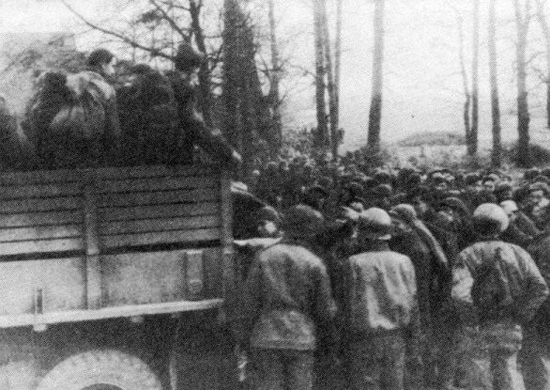
Germany April-May 1945. Recovered American Prisoners of War (RAMPs) are being evacuated by truck to an Air Holding Unit for evacuation to France.
I remember carrying the dead outside and placing the litters on the ground. The Dutch would cover them with beautiful flowers out of respect. It was a sight I will never forget. This kind act made us know that the Dutch appreciated all that we were doing to help in their liberation.
Our stay was somewhat longer at this location as we remained at the site from 18 October until 12 December 1944.
Germany
The First Hospitalization Unit was the first of the 53d Field Hospital’s elements to enter Germany. They were lucky for they were housed in an abandoned office building in Kohlscheid (where they arrived 22 Nov 44 –ed). We joined them on 12 December. In the same month, the entire organization was set up in occupied enemy territory.
Between December 1944 and March 1945, our Platoon would be established in buildings or in tents, with the primary mission of medically supporting a number of Infantry and/or Armored Divisions, advancing through Germany. In January 1945, we lost the able services of our ARC recreation worker, and in April 1945, the remaining ARC staff aide was gone too. Unfortunately, they were never replaced.
Stations in Germany – Second Hospitalization Unit, 53d Field Hospital
Kohlscheid, Germany – 12 Dec 44 > 24 Dec 44
Eschweiler, Germany – 24 Dec 44 > 4 Mar 45
Wickrathberg, Germany – 4 Mar 45 > 31 Mar 45
Senden, Germany – 2 Apr 45 > 12 Apr 45
Brackwede, Germany – 12 Apr 45 > 13 Apr 45
Klötze, Germany – 14 Apr 45 > 6 May 45
Hesslingen, Germany – 6 May 45 > 4 Jun 45
Giessen, Germany – 5 Jun 45 > 5 Jun 45
Kaiserslautern, Germany – 5 Jun 45 > 5 Jun 45
Kirn, Germany – 5 Jun 45 > 15 Jul 45 (ceased operations)
Dorlar, Germany – 15 Jul 45 > 10 Sep 45
Braunfels, Germany – 10 Sep 45 > 10 Nov 45
Calas Staging Area, Southern France (return to ZI)
During the Allied advance into Germany, enemy Prisoners of War captured during the month of April 1945 totaled 23,343 of whom 4,512 were captured while sick in German military and civilian hospitals, where they were left under guard. Evacuation was extremely difficult due to limited transportation and unavailable guard personnel and the distances involved. Because of the limitations as indicated above, hundreds more were disarmed and left under limited armed guard in towns and villages. Allied ex-PWs (RAMPs) uncovered in German camps or freed in transit amounted to 7,207 of different nationalities, the largest groups being Americans, Russians, and British. Their evacuation was accomplished by use of Army Division supply trucks, plus a loan of 2 ½-ton trucks from miscellaneous units from XIII Corps. Personnel were fed from captured German military food stocks, supplemented by our own rations. Medical evacuation and emergency medical treatment were no major problems, as everyone on the hospital staff was eager to contribute and help fellow countrymen.
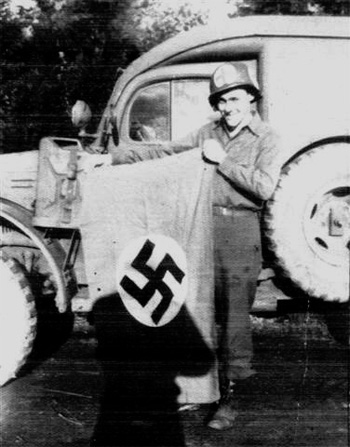
Germany, spring of 1945, picture of Technician 5th Grade A. G. Myhill displaying a captured nazi flag. He stands in front of a WC-54 Ambulance, used by the 53d Field Hospital.
The Second Hospitalization Unit (or Platoon) ceased ALL operations 14 July 1945, at Kirn, Germany. The following day the entire unit moved to a bivouac area at Dorlar, Germany, where it was to remain from 15 July to 10 September 1945 (attached to the 31st Medical Group). Further movement took place to Braunfels, Germany, where the organization was relieved from its previous assignment and attached to the 68th Medical Group. It was at this station, that Alert Orders for Overseas Movement, dated 24 September 1945, were received from Headquarters Seventh United States Army.
The End:
My personal ASR (Adjusted Service Rating –ed) score on 2 September 1945 was 73 points.
I left Europe 27 November 1945, reaching the United States on 9 December 1945.

Colored photo of Marion, Alfred Myhill’s sweetheart whom he married after the war.
I was Honorably Discharged at Fort Dix, Wrightstown, New Jersey, 15 December 1945 (Training, Pre-Staging, and Separation Center, total acreage 28,344, troop capacity 1,825 Off & 51,598 EM –ed), as a Technician 5th Grade, serving with Battery C, 70th Field Artillery Battalion (105mm Howitzers), a non-Divisional unit functioning under USFET (officially inactivated 9 Dec 45, at Cp Patrick Henry, Virginia –ed). My campaign credits include Normandy, Northern France, Rhineland, Ardennes-Alsace, and Central Europe. Decorations consist of the American Campaign Ribbon, the European-North African-Middle Eastern Campaign Ribbon, the World War Victory Medal, and the Army Good Conduct Medal.
Reminiscences:
After returning home, and his folks, Al married his sweetheart Marion 2 months after getting discharged. He had carried her photo with him during the war.
The memories that Alfred Myhill kept of World War Two bring back more than just honor and glory; pictures of dead concentration camp victims, shot by the Nazis; the destruction and devastation of the many towns which the unit passed through; and the war-stricken sight of children who seemed to appear everywhere. When he reached Aachen, Germany, this city looked more devastated than the other places he ever stopped in. Abandoned children loitered near American installations looking for anything of possible use, but in the first place food. After meals, the soldiers dumped their leftovers in the garbage cans, and the kids would be there up to their shoulders pulling out anything that looked edible. And they wanted shoes … any shoe, it didn’t matter. Yes, they were German kids, but they were just kids! Children in the different countries touched his heart and the hearts of his peers. The soldiers would give them chocolate, pieces of clothing, soap, etc.
The 53d Field Hospital felt proud of its accomplishments. During the war the 3 Hospitalization Units treated numerous military casualties belonging to the following Army units: 2d & 5th Ranger Infantry Battalion – 2d Armored Division – 2d Infantry Division – 3d Armored Division – 7th Armored Division – 8th Infantry Division – 29th Infantry Division – 30th Infantry Division – 78th Infantry Division – 83d Infantry Division – 84th Infantry Division – 95th Infantry Division – 102d Infantry Division – and 106th Infantry Division.
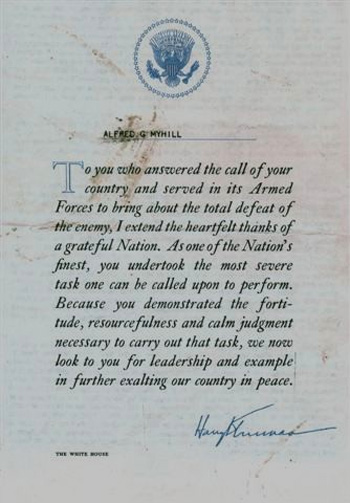
Document emanating from the White House and signed by President Harry Truman, thanking Veteran Alfred G. Myhill for his World War Two Service (the majority of the Vets received such a document following their Honorable Discharge).
Alfred G. Myhill was never wounded while on duty and was proud to be able to say that only one soldier in his unit died and one other was injured during his service years in the E.T.O.
There’s one lesson he’d like to pass on to any future soldier: “They can train you all they want – but when you get there, all changes … you simply have to improvise for war!”
Our sincere thanks go to Tec 5 Alfred G. Myhill (ASN:12214882) for kindly providing some vintage reports of the 53d Field Hospital and sharing some personal recollections and photographs with the MRC staff of the period during which he served with the Second Hospitalization Unit of subject Hospital.
